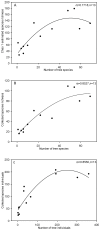Tree diversity mediates the distribution of longhorn beetles (Coleoptera: Cerambycidae) in a changing tropical landscape (southern Yunnan, SW China)
- PMID: 24069421
- PMCID: PMC3777904
- DOI: 10.1371/journal.pone.0075481
Tree diversity mediates the distribution of longhorn beetles (Coleoptera: Cerambycidae) in a changing tropical landscape (southern Yunnan, SW China)
Erratum in
- PLoS One. 2013;8(11). doi:10.1371/annotation/bfe068c2-f5ce-4bc6-83d2-8fe47861ac03
Abstract
Cerambycidae) have been used to identify sites of high biological diversity and conservation value in cultivated landscapes, but were rarely studied in changing landscapes of humid tropics. This study was conducted in a region of southern Yunnan, China, which was dominated by natural rainforest until 30 years ago, but is successively transformed into commercial rubber monoculture plantations since that time. The objectives were to investigate longhorn beetle species diversity and distribution in the major land use types of this landscape and to estimate the effects of an expected expansion of rubber plantations on the longhorn beetle assemblages. The results showed that tree species diversity (181 species in total) and longhorn beetle diversity (220 species in total) were closely related with no significant differences between the tree and longhorn beetles assemblages shown by similarity distance analysis. There was a highly positive relationship between the estimated species richness of longhorn beetles and the number of tree species. Individual numbers of longhorn beetles and trees were also highly positive related at the sampling sites. Non-metric multidimensional scaling revealed that the degree of canopy coverage, succession age and tree diversity explained 78.5% of the total variation in longhorn beetle assemblage composition. Natural forest sites had significantly higher numbers of species and individuals than any other type of habitat. Although young rubber plantations bear the highest longhorn beetle diversity outside forests (half of the total number of longhorn beetle species recorded in total), they can not provide permanent habitats for most of these species, because they develop into closed canopy plantations with less suitable habitat conditions. Therefore, along with an expected expansion of rubber cultivation which largely proceeds at the expense of forest areas, the habitat conditions for longhorn beetles in this region might decrease dramatically in future.
Conflict of interest statement
Figures





References
-
- Holland JD (2007) Sensitivity of Cerambycid biodiversity indicators to definition of high diversity. Biodiversity and Conservation 16: 2599–2609.
-
- Jansson N, Bergman KO, Jonsell M, Milberg P (2009) An indicator system for identification of sites of high conservation value for saproxylic oak (Quercus spp.) beetles in southern Sweden. Journal of Insect Conservation 13: 399–412.
-
- Sugiura S, Tsuru T, Yamaura Y, Makihara H (2009) Small off-shore islands can serve as important refuges for endemic beetle conservation. Journal of Insect Conservation 13: 377–385.
-
- Hanks LM (1999) Influence of the larval host plant on reproductive strategies of cerambycid beetles. Annual Review of Entomology 44: 483–505. - PubMed
-
- Buse J, Ranius T, Assmann T (2008) An endangered longhorn beetle associated with old oaks and its possible role as an ecosystem engineer. Conservation Biology 22: 329–337. - PubMed
Publication types
MeSH terms
LinkOut - more resources
Full Text Sources
Other Literature Sources

